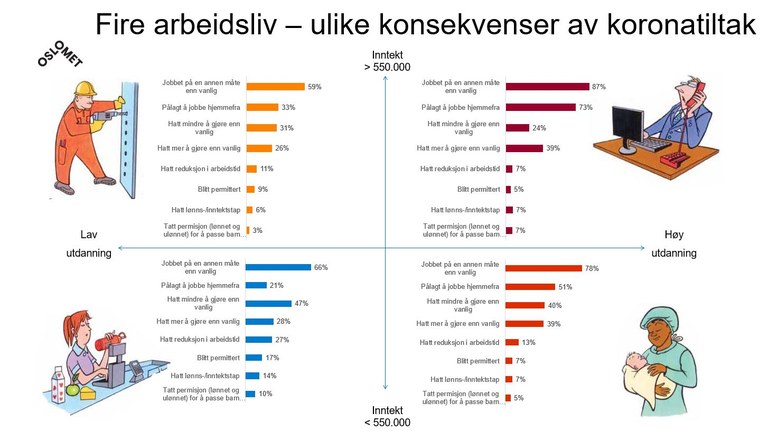Interim Norwegian study of the corona epidemic’s effect on workers
Many Norwegian workers have become pessimistic about the future since the corona epidemic broke out. Those with the lowest levels of education and lowest pay have been the hardest hit. People between 30 and 44 are exposed shows a study from the Norwegian Work Research Institute WRI.
For the past 12 years, WRI has produced an annual study on behalf of the YS trade union looking at how workers view their job situation. This year, a range of questions also explored how workers have been affected by anti-corona measures. When the researchers had received the first 1,177 answers from the 3,000 respondents, they made a preliminary analysis which ended on 6 April.
A large majority of the respondents, 69%, say they now worked in a different manner than before the corona epidemic. 31% say they have less to do, while 36% say they have more. 16% have cut their working hours and 10% have experienced a loss in income. 11% of the respondents have been furloughed.

Download the entire interim WRI report here (in Norwegian): Arbeidslivsbarometerets koronaundersøkelse
“People with the lowest education and pay are experiencing the highest strain as a result of the corona epidemic in Norway. The number of people who are furloughed and which groups are worst hit is connected to the types of measures that have been introduced. All companies offering non-essential personal services, like restaurants, hairdressers, gyms and so on have been closed,” says Arild Steen, who co-authored the study together with Svenn-Erik Mamelund and Mari Holm Ingelsrud.
At the time of the study, a total of 5,500 people in Norway were infected with the coronavirus. Only a small group of these were part of the study, where only 0,3% of the respondents had had their infection confirmed by a lab or a doctor. However, 11,2% believed they had probably had corona.
Large households a risk
The highest number of those who believed they had been infected were between 30 and 44, and lived together with their parents in large households in or near Oslo. In this group the number of infected people was six percentage points higher than the average 17.2%.
Among people living in a large, multi-generational household, the number was 24.9% – double that of the 11.2% who believed they had been ill.
One possible explanation is that these are people who live in close proximity of each other in families with immigrant backgrounds. Infection rates have been high among certain groups, like Somali taxi drivers who drove ski tourists who had been to Austria and Italy home from the airport, according to the Aftenposten newspaper (see separate story).
Nearly all the respondents, 94%, say they wash their hands and use hand sanitiser more often than before. Other advice, like social distancing, avoiding public transport and cancelling meetings, were followed differently according to income and education.
The study divides the labour market into four groups:
It is perhaps not surprising that people with high education find it easier than manual workers to work from home. The largest difference between the groups was seen in how people followed the advice to travel less and to not use public transport.
While 91.3% of people with high education and high income say they follow that advice, only 62.7% of those with low education and low income do the same.
However, personal hygiene is somewhat higher among people with low education and low pay. 85.8% say they wash more or clean more. 82.5% of those with high education and high income say the same.
Women are better at personal hygiene than men, while age play the biggest role. Only 79.5% of 30 to 44 year-olds say they wash more or clean more. The figure for people aged 60 or over is 87.4%. Only 7% of people in all the groups have been using a face mask.
All the four most important anti-infections measures might have had an effect, but the study only found a statistically significant link between washing hands and the number of infected people.
Many want to study
Some questions focused on how the workers viewed their future. These are some of the conclusions from the study:
- Workers who have been furloughed or experienced a loss of earnings are more worried about losing their jobs in the future. They also believe that they might have to change jobs or trades in the future.
- Workers between 30 and 44, many of whom have families to support, are the most likely to be furloughed.
- Workers who have been furloughed express a greater interest in pursuing more education to help them secure a new job – especially workers under 45 and women.
- At the same time, those who are furloughed are not more interested in pursuing further education than other workers, even if it is offered through their current employer.
“The fact that there is much interest in more education, but that people who are furloughed are sceptical about having further or adult education organised by their employer, could be linked to the fact that they believe they will have to change trades. We will witness a transition to what is considered to be safer jobs,” believes Arild Steen.
“Public sector employees have not been furloughed at all during the corona crisis,” he points out.
- Taxi drivers hard hit
-

Some groups in Oslo with immigrant backgrounds have been harder hit than others, including Somali taxi drivers (illustrated above). Out of just over 7,000 infected people in Norway up until 21 April, 300 were of Somali heritage. Large households could be one explanation, but certain occupations could be another.
Taxi driver Mohammed Egeh told Aftenposten that he knew at least ten taxi drivers who had been infected with the coronavirus.
“I know several drivers who have become ill. Many of them have driving passengers from Gardermoen [airport] and from Oslo Central Station. Many of these would have been arriving from skiing holidays in Italy or Austria. It is not easy to keep a one metre distance in a taxi,” says Mohammed Egeh.
 Follow us on Facebook
Follow us on Facebook
